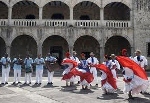Two musical styles that originated in the Dominican Republic have become world famous: merengue and bachata. Both bachata and merengue have their own unique dance style.
Visitors to Santo Domingo can see live performances of traditional music and dances on Friday and Saturday nights at Plaza España and enjoy the live music on Sunday nights at the Monasterio de San Francisco ruins. In addition, bars and nightclubs throughout the city frequently have live music.
Merengue

Merengue is a musical style that dates back to at least 1854. It developed among the lower classes and remained marginalized through the early twentieth century. It was not until the dictator Trujillo rose to power in 1930 that merengue gained wide acceptance.
Of humble origins, Trujillo actively promoted this lower-class music and dance style. He even forced musical groups to compose merengues praising his political party and made it mandatory for dance bands to include merengues in their repertoires.
A traditional merengue band features an accordion, a two–sided drum called a tambora, and a güira (a cylindrical sheet of metal with small bumps on it that is played with a stiff brush).
Internationally known merengue artists include Fernando Villalona, Juan Luis Guerra, Eddy Herrera, Toño Rosario & Los Hermanos Rosario, Los Toros Band, Sergio Vargas, Wilfrido Vargas, Johnny Ventura and Bonny Cepeda.
Bachata

Bachata is a Dominican music style that originated in the early twentieth century. It arose in the rural countryside and poor neighborhoods of this Caribbean country, but has since spread to other parts of Latin America and even Southern Europe.
Bachata evolved from bolero, a Pan-American style said to have originated in Cuba. Bachata combines traditional Latin/Caribbean rhythms with African elements. The typical instruments used are guitars (lead, rhythm and bass), bongos and güiras (see explanation above). The lyrics often feature tales of heartbreak and woe.
Throughout most of its history, bachata was associated with the poor and was considered too rustic and backwards for the mainstream music scene. In fact, the name bachata is a descriptive term that means a rowdy, lower-class party.
It was not until the 1990s that this great musical genre began to receive the recognition it deserves. Today, it is as popular as salsa and merengue in many Latin American dance halls.